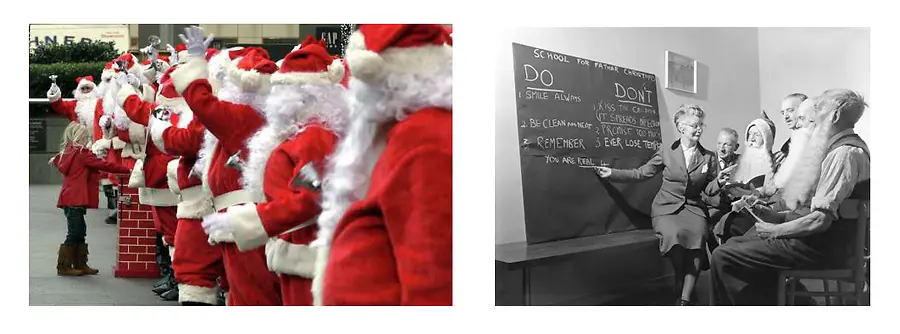The World Needs Sidewalk Santas Again
How the disappearance of Sidewalk Santas reveals what we've lost in our quest for efficiency.

I’ve always loved special-edition magazines—the kind you find around the holidays, like LIFE’s December issue, The Story of Santa. In it, Robert Sullivan does what he does best: pictorially chronicling the evolution of Santa Claus. In the 2015 issue, he made room for a disappearing breed—Volunteers of America’s Sidewalk Santas in Manhattan. Which got me thinking: could this be one of the many things that have quietly, tragically vanished from our world?
We need to bring back Sidewalk Santas.
The first ones appeared in Los Angeles in 1902, ringing bells on street corners and inviting passersby to drop money into cardboard chimneys. Police, baffled, initially hauled them off as public nuisances—but the tradition had already taken root. For 110 years, these surrogate Santas collected donations and embodied holiday generosity. Until 2013.
Restructuring within the nonprofit shifted the model toward more efficient methods such as food vouchers and digital access points. And yes, those systems have advantages—voucher programs let families buy and prepare their own meals with dignity rather than relying solely on soup kitchens or pantries. But something meaningful slipped away in the process.
We lost volunteers like Dale Keyser, a man with a long struggle through bipolar disorder, alcoholism, and homelessness, who cherished those few weeks each year when he donned the red suit on Fifth Avenue. The Sidewalk Santa program helped Keyser—and many others—stay sober, find purpose, and rebuild their lives. One of his fondest memories was the day two busloads of children spotted him, rushed toward him in a joyful tidal wave, and knocked him clean off his feet.
Manhattan’s Sidewalk Santas once planted their portable red chimneys wherever the holiday crowds gathered—from Rockefeller Center to FAO Schwarz. Many came from city shelters with approval from the Department of Homeless Services. Others simply volunteered. All of them endured the cold from noon to eight, Wednesday through Sunday. They traveled in small groups on buses, trains, and subways—car 8065 on the Metro-North out of Grand Central was practically an unofficial Santa shuttle.
Because Volunteers of America’s mission emphasizes “giving every last opportunity for a person to turn his or her life around,” the organization ran a kind of finishing school for its Santas. Don’t smoke in your suit. Avoid onions and garlic. Follow the code.
England took its Santa prep even further. In a 1957 LIFE photograph, Dr. Amy Cohen, an etiquette expert, instructs aspiring Father Christmas stand-ins in Birmingham. To her—and to the culture at the time—Santa was not a role to be played lightly. There were standards. Expectations. A sense of duty.
And when you look at those old guidelines, they feel strikingly relevant today:
Don’t:
- Kiss the children (it spreads infection).
- Promise too much.
- Ever lose your temper.
Do:
- Smile always.
- Be clean and neat.
- Remember you are real.
Maybe, just maybe, these are the ingredients we’re missing—the simple reminders once given to Sidewalk Santas who, despite their own hardships, tried to embody the true spirit of Christmas. For a few brief weeks each year, they remembered they were real. They looked inside their hearts and found hope.
And maybe the rest of us could use a little of that again.


